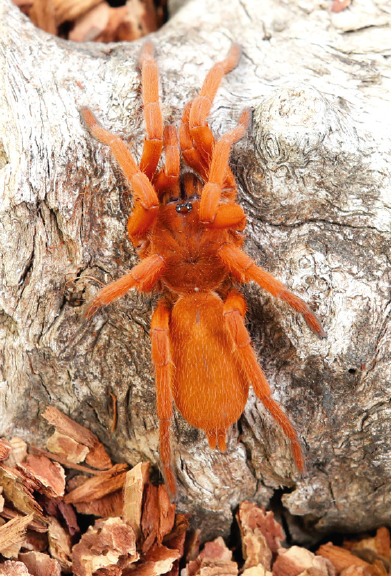The Philippines is a country which is rich in biodiversity in both land and water. As a result, we also have many colorful invertebrates. It’s no surprise that few are aware that tarantulas are endemic to the Philippines.
In the exotic pet hobby, some local species of tarantulas aren’t given much attention; sometimes, this is because people don’t know about them, but sadly, there is also the ‘colonial mentality’ of many people. We can address this by learning more about the various breeds and species, and in this article, we’ll meet the Selenobrachys philippinus or Orphnaecus philippinus.
Meet the Philippine Orange Tarantula
Local tarantulas exist in a variety of shapes, colors and sizes, and one of the most striking of them is the Philippine orange tarantula. This tarantula, known internationally as the Philippine tangerine, has recently been reclassified as the Orphnaecus philippinus; it was previously known as the Selenobrachys philippinus.

Their habitats are in colder parts of the forests such as burrows in the forest floor and other places with damp soil in which they prefer to make webs and burrows. They thrive in places with lower temperatures ranging from 24-28°C since they usually live in places with higher elevations. Called the Philippine orange for short, the Philippine orange tarantula is internationally famous for its exceptional and striking color. They are also known as burrowers and heavy webbers, a trait that is common in most terrestrial Asian species of tarantula.
Most local tarantulas don’t have a very bright and vivid coloration on their bodies, which makes the Philippine orange stand out in its class. The most entertaining part of this specimen is when they construct their webbing around their enclosures, and their eating habits, since they are ambush predators.
Local tarantulas mainly differ from other tarantulas because of the region they came from. Their anatomy is different, having evolved to cope with their different habitats. For example, New World tarantulas mainly found in the American regions have urticating hairs; they can flick these tiny barbed hairs at their predator or attacker, and they prefer to use this defense mechanism before striking.
On the other hand, Old World tarantulas from Asia, Africa, and Australia do not have this type of defense. The Philippine orange tarantula belongs to this Old World tarantula category. Old World tarantulas rely on their speed and venom to survive a threat. This is why tarantulas from the Old World regions are quicker to flee and tend to bite when cornered.

Preservation Imperative
The Philippine orange tarantula is difficult to breed in captivity. No known captive breeding of this tarantula has taken place in the country, though a few hobbyists in international invertebrate forums claim to have bred this species in captivity. Some specimens considered by some as captive bred specimens; these are from wild caught specimens just waiting to lay their eggs, and were not mated in captivity. These eggs are incubated and eventually become spiderlings.
The right parameters, similar to their natural habitat, are difficult to reproduce in captivity unless the tarantulas are kept in a laboratory setup; however, this hasn’t been tested in the laboratories since very little research has been done on these specimens.The status of the Philippine orange tarantula in the wild is unknown, due to the lack of studies done on this specimen. However, their distribution here in the Philippines is in a very small location only.
Just as other species are threatened by habitat loss and deforestation, the Philippine orange tarantula is no exception.Now that we are shedding some light on local tarantulas, we now know there is still a lot to be learned about them. We should take care of the forests to protect our local tarantula species. You never know―the next new species of tarantula might just be in your backyard! Some local tarantulas are so common that they can easily be found in any garden. The local terrestrial biodiversity has such a variety that the Philippines also has several species of local scorpions. That’s why preserving natural habitats and biodiversity is important.
This first appeared in Animal Scene’s May 2015 issue.






